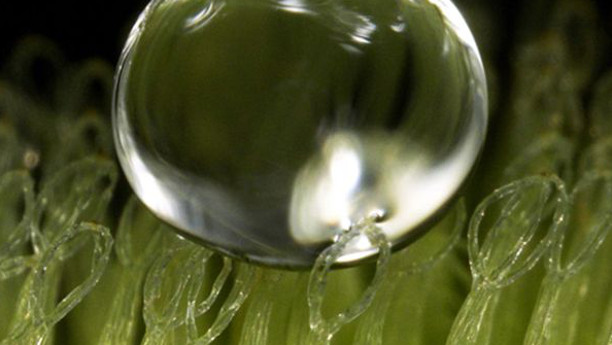Water fern inspired nanofur to clean up oil spills
The oil spill in the Gulf of Mexico in 2010, is one of the worst environmental disasters of recent year. After the explosion at the BP operated drilling rig Deepwater Horizon, an estimated 800 million litres of crude oil spilled into the sea.

An oil slick measuring 10,000 square metres endangered marine animals, sea birds and costal inhabitants. Until now, oil spills have been cleaned up by burning the oil, or using dispersion materials, which decompose the oil with the use of chemicals. These methods have been controversial for a long time because they equally pollute the environment. According to environmental scientists, the dispersant chemicals used can cause genetic mutation and cancer, adding to the toxicity of the spill.
Water ferns' oil absorbing abilities
Scientists based at Karlsruhe Institute of Technology's Institute of Microstructure Technology (KIT) have now found an environmentally friendly solution to clean up oil-contaminated waters. Reporting their latest results in the journal Bioinspiration & Biomimetics, the team of scientists, led by material researcher Claudia Zeiger, said they were inspired by nature. In their study, the researchers focused on several water plants including four species of aquatic ferns – Salvinia – which are well known for their oil-absorbing abilities, making the leaves water repellent. “We already knew that the leaves of these plants repel water, but for the first time now, we have studied their capacity to absorb oil,” explains Zeiger. Together with colleagues from the University of Bonn, the team discovered the secret behind the oil absorption. The answer lies in the oil-binding properties of the hair-like microstructures called trichomes on the leaf surface.
Microhairs shaped like eggbeaters
Tiny little outgrowths called trichomes, which are similar to hairs and between 0,3 and 2,5 millimetres long, cover the surface of the Salvinia. When compared to different varieties of Salvinia, the scientists established that it was not the leaves with the longest hairs that absorbed the most oil, but the oil-binding ability is determined by the shape of the microhairs' ends. “From our results we now know that the shape of the hair ends is important in supporting the oil/air interface to ensure maximum oil absorption and retention capabilities," Zeiger stresses. The type of water fern that absorbed most of the oil is called Salvinia molesta. It is native to Brazil and its microhairs look like miniature eggbeaters and are joined together at the ends. Salvinia was able to absorb most of the oil. Furthermore, tests have shown that the water ferns are able to absorb oil in a matter of seconds.
The aquatic plants, which are native to the tropics and subtropics is now also increasingly found in European waters. For some, the plants have become a plague because they spread rapidly. This is another point why the Karlsruhe researchers are in favour of using the water plants as oil absorbers. They are not only fast and environmentally friendly, but also a cost-effective alternative to chemical cleaning of oil-contaminated waters. “The plants could be used for example in lakes where oil has accidentally entered the lake,” explains Zeiger.
Natural model for plastic films
In order to clean up oil spills, the Karlsruhe researchers now want to transfer their newly acquired knowledge on the Salvinia aquatic plants to a bio-inspired plastic film technology developed by them. The scientists have developed a synthetic version of these hairy surfaces and called it nanofur. The plastic nanofur is made up of microhairs on the film’s surface. It mimics the water-repellent and oil-absorbing effect of Salvinia to separate the oil and water.


